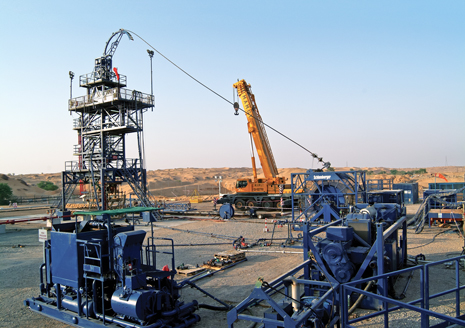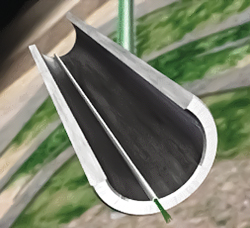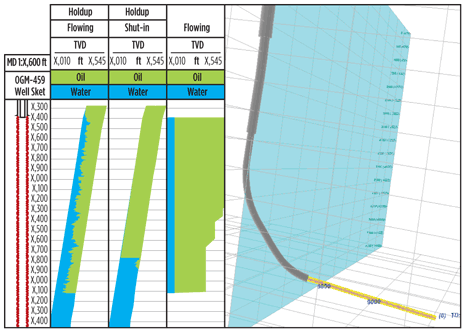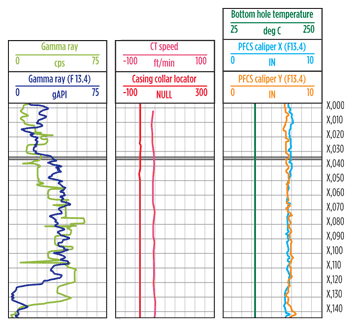JORGE DUARTE OLARTE, SURAJIT HALDAR, RIFAT SAID, Saudi Aramco; ANTON BUROV, WASSIM KHARRAT, JOHN STUKER, Schlumberger
 |
| Fiber-optic enabled coiled tubing operation underway in the southern region of Saudi Arabia. |
|
Oil wells in the south of Saudi Arabia are mostly horizontal openhole (OH) completions. Some of these wells are dead or on intermittent production due to high water cut, owing to the influx of water through fissures or fractures. Overcoming this problem requires water shut-off (WSO), typically performed using mechanical and/or chemical barriers in the wellbore and/or reservoir. The WSO candidate well selection process starts with the evaluation of reservoir and production data, typically followed by a coiled tubing (CT) logging run to identify the water source and to help design the placement, formulation and volume of required isolating fluids. Water-producing zones can either be permanently isolated or shut-off temporarily while acid stimulation is applied to oil-producing zones.
During 2005–2010, several attempts were made using inflatable packers—deployed using CT—as a cement retainer and/or bridge plug to mechanically isolate unwanted zones. Consequently, when set in OH zones with excessive ovality and/or wash-out, the expansion capabilities of the packers were often found to be insufficient to achieve adequate isolation. Therefore, accurate depth and X-Y caliper measurements are key parameters for effective WSO treatment in an OH completion. Conventional CT systems measure depth, based on the length of CT in-hole, while bottomhole information, such as pressure and tension/compression, are calculated from surface information. Such systems can introduce inaccuracies in downhole monitoring and control that reduce the effectiveness of the WSO treatment, resulting in higher water cut than could otherwise be achieved.
A fiber-optic enabled coiled tubing (FOECT) system has been utilized to provide reliable, real-time, bottomhole data measurements that have enabled more accurate packer setting depth, adequate inflation within packer limitations, and optimization of cement design and injection. The new approach has improved the accuracy of completion engineering through the entire WSO design-execution-evaluation process, and has delivered a higher success rate for the treatment.
FIBER-OPTIC ENABLED COILED TUBING TECHNOLOGY
The FOECT system includes a fiber-optic (FO) cable installed inside a CT string, a FO bottomhole assembly (FOBHA), surface electronics and software. The FO cable (Fig. 1) is light—about 1/20 the weight of an equivalent electric cable—and can withstand corrosive bottomhole conditions and temperatures up to 300°F. It is installed within a 1.8-mm (0.071-in.) outside diameter (OD) carrier, making it nonintrusive to the CT internal diameter (ID), so CT operations normally done with conventional strings—such as pumping corrosive fluids or dropping balls—can still be performed.
 |
| Fig. 1. Schematic of the fiber-optic cable carrier in a section of coiled tubing. |
|
The FO cable, itself, provides reliable, accurate, real-time distributed temperature sensing (DTS) measurements throughout the length of the CT, and it does not require calibration prior to running in a well. During typical operation of the FOECT system, downhole data are transmitted from the working reel via wireless communication to the CT control cabin, where the monitoring system and specialized software collect, display, monitor and record real-time job parameters. The surface acquisition system can also communicate with, and send commands to, the downhole tool. The FOECT system provides real-time downhole measurements of:
-
X-Y caliper to evaluate OH geometry and conditions, and determine optimum target depths to set inflatable packers
-
Casing collar locator (CCL) and gamma ray (GR), enabling accurate depth control for packer setting
-
Bottomhole pressure (BHP) inside and outside the CT string, enabling proper inflation of the packer and eliminating the risk of exceeding its operating limitations during the injection of WSO fluids
-
Tension/compression (TC) forces to confirm adequate packer setting and disconnect
-
Bottomhole temperature (BHT) outside the CT string, enabling adjustment of the cement formulation and aiding the design of any other required WSO fluids.
The FOECT X-Y caliper tool transmits real-time downhole measurements, which previously required a separate wireline logging job, from a conventional X-Y caliper attached to the head of the CT string. It is powered by a lithium battery with more than 72-hr operating duration.
The FOECT TC module has a 2⅛-in. OD and can handle up to 2 bpm pumped through it. The tool can measure tension, compression and torque loads.
CASE STUDY: WELL-A
Well-A has a 6⅛-in. OH horizontal section from 7,387 ft to a total depth of 9,950 ft, Fig. 2. Water cut increased in early 2004 with a simultaneous decrease in oil production. A production test prior to WSO treatment indicated 43.9% water cut. Production logging in 2005, after initial WSO treatment, indicated 29.6% water cut, with most of the oil production coming from clusters of conductive carbonate fractures. Newer oil and water saturations were assessed by logs obtained in 2010. Based on this production information, a plan for remedial action was developed that would plug-back the well to 7,923 ft, to isolate the fracture clusters that showed high water saturations and enhance oil recovery from the upper section. Isolation was to be achieved using two 3-in. OH thru-tubing inflatable packers with cement squeezed in-between and a cap of cement above the second packer to anchor it. The operations were performed rigless, using FOECT WSO treatment services that included multiple run-in-hole (RIH) jobs:
-
RIH with FOECT X-Y caliper tools
-
RIH first (lower) inflatable packer
-
RIH second (upper) inflatable packer and pump cement
-
RIH with TC sub to confirm new TD
-
Flow back the well using nitrogen, if necessary.
 |
| Fig. 2. Well-A production profile and hole survey |
|
RIH-1: Depth correlation and OH geometry evaluation. The objectives of the first RIH were to ensure wellbore completion accessibility; correlate depths; confirm WSO design feasibility based on OH geometry; evaluate OH roundness/ovality to determine appropriate depths to set inflatable packers; and confirm the volume of the cement needed to achieve the desired top-of-cement TD.
The BHA of the CT was run with a 3-in.-OD tool—the maximum OD of the inflatable packer element. Depths were correlated against a reference log and completion report using the FOECT CCL and GR readings (Fig. 3), after which the CT was RIH to the target depth and flagged. The GR measurements indicated that depths at the WSO target needed to be adjusted by 15 ft to be “on depth” with the reference log, due to issues such as CT stretching and finite repeatability of the depth encoder.
 |
| Fig. 3. Fiber-optic enabled CT CCL gamma ray log |
|
Evaluation of OH ID and surface smoothness indicated optimum setting depths of 8,220 ft for the lower packer and 8,060 ft for the upper packer. Real-time CT weight measurements were utilized to evaluate friction coefficients of the well and confirm that sufficient weight could be applied on the packer after inflation to ensure it was properly set before the CT lockup. Based on the FOECT X-Y caliper logs evaluation of the OH size, the cement volume between the two packers was increased from the planned 5 bbl to 7 bbl.
RIH-2: Setting first inflatable packer. A 3-in.-OD inflatable packer was set at 8,220 ft. Depth control was based on the CCL tool while in tubing and the GR tool in OH. BHP was evaluated constantly while running in hole to avoid premature inflation of the packer. BHP measurements also prevented packer damage during inflation or exceeding packer differential limits and reservoir fracture pressure during the subsequent cement squeeze. The TC sub was used to confirm the packer was properly set and released. Pump rate during inflation reached 1.4 bpm and an inflation differential pressure of about 2,800 psi. No over-pull was seen for packer release, so a pump test was conducted. The pressure was much less, which indicated that the packer was released as designed. The CT string was flagged at 8,060 ft—the required depth of the second packer, while pulling out of hole.
RIH-3: Setting second inflatable packer and cementing. Additional weight was set on the second packer to help ensure maintained connection during inflation. At the start of the process, the inline universal valve opened at around 1 bpm with 2,400-psi differential pressure on the packer. A subsequent injection test confirmed that the inline universal valve was open.
A laboratory test was performed while the second packer was set on-depth and the cement recipe was adjusted to fit actual bottomhole conditions. A spacer volume of 5 bbl was pumped through the CT string to mitigate subsequent cement contamination. Cement was then squeezed 4 bbl between the packers and the remaining 3 bbl above the top packer. An additional 5 bbl of spacer was pumped to clean up the wellbore. The well was then shut in for 24 hr to allow the cement to develop sufficient compressive strength.
RIH-4: Confirming new TD. The CT was run in hole to confirm top of cement, which was found at 7,923 ft (2,000 lb slack-down weight), 137 ft above the upper packer.
FOECT WSO RESULTS
This case was the world’s first application of X-Y Caliper, BHT, BHP, CCL, GR and TC technologies in one FOECT job. The FOECT remedial WSO treatment applied to Well-A recovered its stable oil production and delivered a 70% decrease in water cut. The results prove the viability of this new approach to accurately evaluate well conditions, control depth, and monitor bottomhole parameters to allow proper placement of WSO fluids into the target zone and isolate water producing intervals in OH. The reliable real-time data provided by FO technology also supports the design and implementation of critical operational parameters in other CT applications such as stimulation and perforation. 
ACKNOWLEDGMENT
The authors thank Saudi Aramco and Schlumberger management for permission to publish this work. This article was prepared from SPE 149116, presented at the SPE Saudi Arabia Section Technical Symposium and Exhibition, held in Al Khobar, Saudi Arabia, May 15-18, 2011.
|
AUTHORS
|
 |
JORGE DUARTE OLARTE is a production engineer working in the Gas Production Engineering Division, Saudi Aramco. In 1996, Mr. Olarte received his BS in Petroleum Engineering from the Universidad America, Bogota, Colombia. |
|
 |
SURAJIT HALDAR is a stimulation and water shutoff champion for water and oil wells in Saudi Aramco’s Southern Area Production Engineering Department (SAPED). Mr. Haldar received both his BS in chemical engineering (1989) and his MBA (2006) from the Indian Institute of Technology, Kharagpur, India. |
|
 |
RIFAT SAID worked for Schlumberger for 18 years before joining Saudi Aramco in Sept. 2006. Currently, Mr. Said works as a stimulation engineer, providing technical support to SAPED. He received his BS in mechanical engineering (1986) from the University of Indonesia, Jakarta. |
|
 |
ANTON BUROV is the senior account manager for Schlumberger well services in Saudi Arabia. Mr. Burov earned an MS degree in mechanical engineering (2000) from the Russian State Technical University of Volgograd . |
|
 |
WASSIM KHARRAT joined Schlumberger in September 1998. Currently, Mr. Kharrat is working as the coiled tubing district technical engineer in Udhailiyah. In 1998, he received his MS degree in mechanical and industrial engineering from École Nationale Supérieure d'Arts et Métiers (ENSAM), France. |
|
 |
JOHN STUKER joined Schlumberger in 2003. He is a general field engineer for coiled tubing, specializing in fiber optic and downhole tools. Mr. Stuker received his BS in mechanical engineering (2003) from Montana State University. |
|












